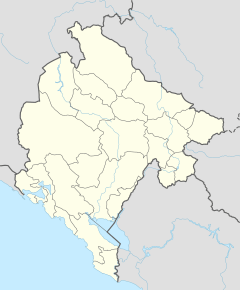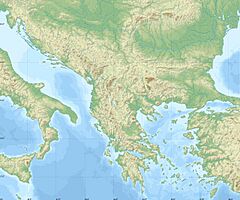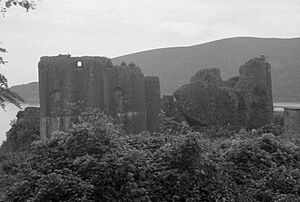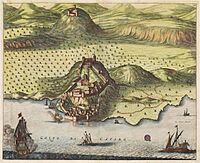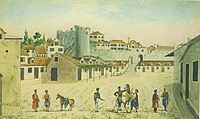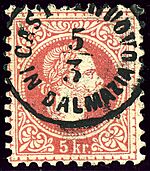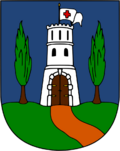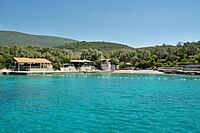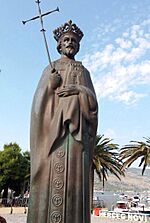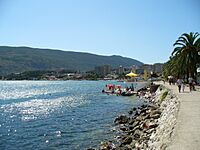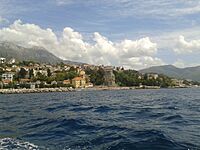Herceg Novi facts for kids
Quick facts for kids
Herceg Novi
Херцег нови
|
|||
|---|---|---|---|
|
Town and municipality
|
|||
|
Herceg Novi
|
|||
|
|||
| Country | |||
| Municipality | |||
| Founded as Sveti Stefan | 1382 | ||
| Settlements | 27 | ||
| Area | |||
| • Town and municipality | 235 km2 (91 sq mi) | ||
| Population
(2011 census)
|
|||
| • Rank | 3rd in Montenegro | ||
| • Density | 140/km2 (400/sq mi) | ||
| • Urban | 19,536 | ||
| • Rural | 11,328 | ||
| • Municipality | 30,864 | ||
| Time zone | UTC+1 (CET) | ||
| • Summer (DST) | UTC+2 (CEST) | ||
| Postal code |
85340
|
||
| Area code | +382 31 | ||
| ISO 3166-2 code | ME-08 | ||
| Car plates | HN | ||
| Website | |||
Herceg Novi (Cyrillic: Херцег Нови) is a town in the coastal region of Montenegro. It is located at the western entrance to the beautiful Bay of Kotor. The town sits at the foot of Mount Orjen.
Herceg Novi is the main town of the Herceg Novi Municipality. About 33,000 people live there. The town was first built as a fortress in 1382. It was founded by the King of Bosnia, Tvrtko I Kotromanić. He named it after Saint Stephen, but people soon called it Novi, meaning "New". In Italian, it was known as Castelnuovo, which also means "New Castle".
Herceg Novi has a long and interesting history. It has been ruled by many different groups. This has given the city a mix of cool and different building styles. Even though it's one of the newer towns on the Adriatic coast, it has seen a lot of changes!
Contents
What's in a Name?
When Tvrtko I of Bosnia founded the town, he named it after Saint Stephen. But people quickly started calling it Novi, which means "New" in the local language. It was also known as Castelnuovo in Italian, meaning "New Castle".
Later, the town came under the control of the Kosača noble family. It became their winter home. During this time, the town got a new name. They added the title herceg (which means "duke" in Serbo-Croatian) from Stjepan Vukčić Kosača to the name Novi. This is how it got its current name, Herceg Novi.
In Montenegrin, it's called Herceg Novi or Херцег Нови. In Italian, it's Castelnuovo. In Greek, it's Neòkastron. All these names mean 'new castle'. The name Herceg Novi, as we know it today, was first written down in a Turkish document in 1726.
A Look Back: Herceg Novi's History
Long, long ago, people lived in this area. Archeological finds show that people were here during the Stone Age and early Bronze Age. In the 3rd century BC, the Roman Republic took control after winning against the Illyrians.
After the Roman Empire split, the area was ruled by the Byzantine Empire. Slavic tribes then moved into these lands around the 7th century AD. The small settlement was part of a Byzantine area called Dračevica. This area later belonged to the Principality of Travunija.
How Herceg Novi Was Founded
The Bosnian kingdom needed a good port on the Adriatic Sea. King Tvrtko I of Bosnia decided to build a new town. In 1382, he built a new fortress in the Bay of Kotor. It was built where a small fishing village used to be. He wanted it to be a new center for trading salt.
He first named the city after Saint Stephen. But people quickly started calling it Novi, meaning "new".
After King Tvrtko died, Duke Sandalj Hranić took over Novi. During his time, the town became important for salt trading. When he died, his nephew, Duke Stjepan Vukčić Kosača, inherited it. The town grew even more important and became Stjepan's winter home. This is when it got its new name: Herceg Novi.
Under Ottoman Rule
The Ottomans took over Herceg Novi in 1481. They ruled for about 200 years. The Ottomans built the Kanli Tower, which is still there today.
For a short time, between 1538 and 1539, the Spanish held the town. They built a fort called Hispaniola above the city. This fort is still very well-preserved.
In 1608, a big earthquake hit Herceg Novi and caused a lot of damage.
Modern Times
In 1687, the city was captured by the Republic of Venice. It became part of their territory called Albania Veneta. The Venetians made the old town walls and towers stronger. They also added a Citadella tower, but it was destroyed in an earthquake in 1979.
Herceg Novi was then taken by Austria in 1798. But it was later given to Russia in 1805. The Russians officially controlled Herceg Novi from 1806 to 1807.
Then, in 1807, Herceg Novi was given to Napoleon I Bonaparte's French Empire. The French ruled the city from 1807. It was part of Dalmatia and then the new Illyrian Provinces.
In 1813, Montenegrin forces took over Herceg Novi. It was under a temporary government supported by Montenegro. But in 1814, Austrian forces arrived. The Prince-Bishop of Montenegro handed the territory over to Austrian control. The Bay of Kotor, including Herceg Novi, was under Austro-Hungarian control until 1918.
The 20th Century
During World War I, the Kingdom of Montenegro tried to take back the Bay of Kotor. But by 1916, Austria-Hungary defeated Montenegro.
In 1918, the Serbian Army entered the bay. People welcomed them as Slavic liberators. The bay then became part of the Kingdom of Serbs, Croats and Slovenes, which was later called Yugoslavia.
During World War II, Herceg Novi was taken by Italy in 1941. It became part of the province of Cattaro.
Yugoslav Partisan forces later took back Herceg Novi in 1943. After the war, Herceg Novi became part of the People's Republic of Montenegro within Yugoslavia.
In 1970, a famous blitz chess tournament was held in Herceg Novi. It featured four World Champions and was considered one of the strongest blitz tournaments ever!
People of Herceg Novi
The Herceg Novi municipality stretches along the coast. Many towns are located along this strip. In 2011, about 30,864 people lived in the municipality.
Different Backgrounds
People from many different backgrounds live in Herceg Novi. Here's a look at the main groups from the 2011 census:
| Ethnicity | Number | Percentage |
|---|---|---|
| Serbs | 5,002 | 45.23% |
| Montenegrins | 4,013 | 36.28% |
| Croats | 309 | 2.79% |
| Yugoslavs | 83 | 0.75% |
| Bosniaks | 63 | 0.59% |
| ethnic Muslims | 61 | 0.59% |
| Romani | 46 | 0.41% |
| Macedonians | 44 | 0.39% |
| Russians | 44 | 0.39% |
| Albanians | 21 | 0.18% |
| Slovenians | 21 | 0.18% |
| Hungarians | 17 | 0.15% |
| Italians | 14 | 0.12% |
| Other | 48 | 0.43% |
| not declared | 1080 | 9.76% |
| Total | 11,059 | 100% |
Religions in Herceg Novi
People in Herceg Novi follow different religions. Here are the numbers from the 2011 census:
| Religion (2011 census) | Number |
|---|---|
| Eastern Orthodoxy | 8,994 |
| Islam | 192 |
| Catholicism | 546 |
| Christians | 45 |
| Jehovah Witness | 0 |
| Buddhist | 0 |
| Adventist | 19 |
| Agnosticism | 37 |
| Atheism | 415 |
| Undeclared | 738 |
| Other | 57 |
Fun Things to Do: Tourism
Herceg Novi is a popular place for tourists in Montenegro. It's known as a spa and health center. Nearby Igalo has lots of "igaljsko blato" (healing sea mud) and "igaljske slatine" (mineral springs). These are great for health treatments!
Some famous places to visit in Herceg Novi include:
- Forte Mare castle: Built by the Bosnian king Tvrtko I in 1382.
- Clock tower: Built by the Austrians in the 19th century.
- Kanli tower: Built by the Turks.
- Old churches and monasteries: Like the Church of St. Ilija, the Church of the Holy Salvation, and the Savina Monastery.
While the city itself doesn't have long sandy beaches, you can easily reach many beaches by boat. Tourist companies offer one-day boat trips to the Luštica peninsula. This peninsula is right across from the town. Popular beaches there include Žanjic, Mirište, and Rose.
Culture and Arts
"JUK Herceg-Fest" is a cultural center that started in 1992. It helps organize many fun events in the city. These include the mimosa celebration, local plays, and film and music festivals.
The Operosa Opera Festival happens in the summer. It takes place in the Kanli Kula amphitheater, which is inside the old fortress. It also uses the Forte Mare fortress.
The Herceg Novi City Archive keeps old documents and records. The oldest document there is from 1685! The archive also has a library with about 30,000 books. It's open to the public.
The Historical Museum opened in 1953. The building was a gift to the city from a former mayor, Mirko Komnenović.
The City library has at least 30,000 books. Many people have donated books to this collection.
Getting Around: Transportation
Herceg Novi is often the last stop for buses coming from Montenegro and Serbia. The Adriatic Motorway, a two-lane road along the coast, goes through Herceg Novi. It connects to the Croatian road network at the Debeli Brijeg border.
A ferry operates across the Verige Strait. This ferry helps you avoid driving all the way around the Bay of Kotor. It makes it easier to reach towns like Tivat, Kotor, and Budva.
Tivat Airport is about 23 kilometers (14 miles) away if you take the ferry. It has regular flights to Belgrade and Zürich. Many charter planes also land there in the summer. Dubrovnik Airport in Croatia is about 30 kilometers (19 miles) away. It has regular flights to many European cities.
Weather in Herceg Novi
The Bay of Kotor area has a humid subtropical climate. This means it gets a lot of rain in the winter. Herceg Novi has its own special weather. This is because it's close to the sea and has mountains behind it. The mountains help block cold air.
Herceg Novi gets about 200 sunny days each year. In July and August, there are about 11 sunny hours every day.
The average temperature for the whole year is about 16.2°C (61.2°F). This is similar to cities like Naples and Lisbon. The temperature doesn't change much during the day, usually only about 4°C (7.2°F). In summer, from May to September, the average temperature is around 25°C (77°F). The sea temperature in summer is also warm, between 22°C and 26°C (72°F and 79°F).
The area gets about 1930 mm (76 inches) of rain each year. The air is most humid (80%) in the fall. It's least humid (63%) in the summer.
| Climate data for Herceg Novi (1991–2020, extremes 1948–present) | |||||||||||||
|---|---|---|---|---|---|---|---|---|---|---|---|---|---|
| Month | Jan | Feb | Mar | Apr | May | Jun | Jul | Aug | Sep | Oct | Nov | Dec | Year |
| Record high °C (°F) | 21.4 (70.5) |
23.6 (74.5) |
27.0 (80.6) |
30.2 (86.4) |
33.1 (91.6) |
36.6 (97.9) |
39.2 (102.6) |
42.0 (107.6) |
35.8 (96.4) |
30.9 (87.6) |
26.4 (79.5) |
21.2 (70.2) |
42.0 (107.6) |
| Mean daily maximum °C (°F) | 13.0 (55.4) |
13.7 (56.7) |
15.9 (60.6) |
19.3 (66.7) |
23.8 (74.8) |
28.3 (82.9) |
31.3 (88.3) |
31.7 (89.1) |
26.9 (80.4) |
22.5 (72.5) |
17.9 (64.2) |
14.0 (57.2) |
21.5 (70.7) |
| Mean daily minimum °C (°F) | 4.8 (40.6) |
4.8 (40.6) |
7.0 (44.6) |
9.9 (49.8) |
13.9 (57.0) |
17.8 (64.0) |
20.0 (68.0) |
20.6 (69.1) |
16.7 (62.1) |
13.4 (56.1) |
9.7 (49.5) |
6.1 (43.0) |
12.1 (53.7) |
| Record low °C (°F) | −7 (19) |
−5.6 (21.9) |
−3.2 (26.2) |
0.0 (32.0) |
4.8 (40.6) |
9.2 (48.6) |
12.0 (53.6) |
9.2 (48.6) |
7.8 (46.0) |
2.0 (35.6) |
−3.6 (25.5) |
−4 (25) |
−7 (19) |
| Average precipitation mm (inches) | 231.3 (9.11) |
195.4 (7.69) |
198.8 (7.83) |
159.2 (6.27) |
103.7 (4.08) |
63.6 (2.50) |
47.3 (1.86) |
87.7 (3.45) |
151.5 (5.96) |
199.2 (7.84) |
256.1 (10.08) |
235.6 (9.28) |
1,929.4 (75.95) |
| Average precipitation days (≥ 0.1 mm) | 14 | 13 | 13 | 12 | 10 | 8 | 6 | 6 | 8 | 10 | 14 | 15 | 129 |
| Average relative humidity (%) | 72 | 70 | 70 | 72 | 73 | 71 | 64 | 66 | 70 | 72 | 75 | 73 | 71 |
| Mean monthly sunshine hours | 110.5 | 113.7 | 160.1 | 191.6 | 254.2 | 288.4 | 343.0 | 315.8 | 249.6 | 190.1 | 114.3 | 101.6 | 2,432.9 |
| Source 1: Hydrological and Meteorological Service of Montenegro | |||||||||||||
| Source 2: National Oceanic and Atmospheric Administration | |||||||||||||
Friends Around the World: Sister Cities
Herceg Novi is twinned with many cities around the world. This means they are friendly partners and often share culture and ideas.
 Bačka Topola, Serbia
Bačka Topola, Serbia Banja Luka, Bosnia and Herzegovina
Banja Luka, Bosnia and Herzegovina Barletta, Italy
Barletta, Italy Beočin, Serbia
Beočin, Serbia Bitola, North Macedonia
Bitola, North Macedonia Čajetina, Serbia
Čajetina, Serbia Centar (Sarajevo), Bosnia and Herzegovina
Centar (Sarajevo), Bosnia and Herzegovina Foča, Bosnia and Herzegovina
Foča, Bosnia and Herzegovina Guglionesi, Italy
Guglionesi, Italy Kotor Varoš, Bosnia and Herzegovina
Kotor Varoš, Bosnia and Herzegovina Kranj, Slovenia
Kranj, Slovenia Kristiansand, Norway
Kristiansand, Norway Levanger, Norway
Levanger, Norway Loznitsa, Bulgaria
Loznitsa, Bulgaria Mali Zvornik, Serbia
Mali Zvornik, Serbia Novo Mesto, Slovenia
Novo Mesto, Slovenia Odesa, Ukraine
Odesa, Ukraine Osijek, Croatia
Osijek, Croatia Prizren, Kosovo
Prizren, Kosovo Senec, Slovakia
Senec, Slovakia Szeged, Hungary
Szeged, Hungary Trebinje, Bosnia and Herzegovina
Trebinje, Bosnia and Herzegovina Vauréal, France
Vauréal, France Volgorechensk, Russia
Volgorechensk, Russia Zemun (Belgrade), Serbia
Zemun (Belgrade), Serbia Zaječar, Serbia
Zaječar, Serbia
Images for kids
See Also
 In Spanish: Herceg Novi para niños
In Spanish: Herceg Novi para niños










